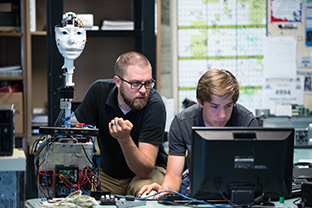May 26, 2017
SVSU, Dow Corning Foundation STEM program rewards Kingston teacher's eye for the future
 “Robots shall inherit the classroom” reads the tagline on Matt Ferguson’s Kingston High School-based webpage featuring his Robotics course’s trials and tribulations.
“Robots shall inherit the classroom” reads the tagline on Matt Ferguson’s Kingston High School-based webpage featuring his Robotics course’s trials and tribulations.
It’s a maxim that may sound hyperbolic to some, but to Ferguson and his students, it’s a work in progress. In Room 39 of the high school — surrounded by the rural landscapes of Michigan’s Thumb region — a high-tech endeavor is underway that one day (soon) could result in a robot inheriting some of Ferguson’s classroom responsibilities.
“Maybe by this time next year,” Ferguson said of his timeline to finish building InMoov, a life-sized 3D-printed robot whose blueprints are available as an open source project for educators and hobbyists alike.
That time line reached much deeper into the future before Ferguson became involved in the Dow Corning Foundation/Saginaw Valley State University Community STEM Partnership. That initiative has provided resources and training since 2014 for K-12 teachers interested in ramping up student interest in the sciences. In 2016, Ferguson was selected to participate in the program along with 27 other educators from 14 schools in 12 districts spanning Bay, Midland, Saginaw and Tuscola counties.
That same cohort of K-12 teachers will provide presentations on their resulting projects during a symposium Tuesday, May 30, from 4:30 p.m. to 7 p.m. in SVSU’s Curtiss Hall. The event is free and open to the public. Ferguson will be among the presenters. He plans to bring InMoov to the occasion.
“We wouldn’t be working on the InMoov project right now if it weren’t for the fellowship,” said Ferguson, who received a bachelor’s degree in art education from SVSU in 2005.
The Peck native began eyeing InMoov years ago, but lacked the resources. Through the Dow Corning Foundation/SVSU Community STEM Partnership, he received $2,000 in funds along with grant-writing skills — offered as part of the program’s professional development courses — that helped him successfully lobby for additional support from other sources. He used the financial support to buy the materials that make up InMoov as well as the 3D printers that shaped those materials into the life-sized figure.
Stephanie Brouet, an SVSU associate professor of chemistry and one of the STEM partnership’s coordinators, remembered speaking for the first time last year with Ferguson about his ambitions to build an InMoov model.
“It’s astonishing what he and his students have been able to do since then,” she said. “I was thinking, by this point, he might have the 3D printers. They’re much farther along than I thought they would be.”
Ferguson and his Robotics class first began printing parts for InMoov in November 2016. The venture began with construction of a faceplate. Since then, the group has built nearly 100 items on a 400-item checklist of InMoov parts.
Students involved in the project say they are inspired by it.
“This has definitely increased my interest in the sciences,” said Nathan Scott, a Kingston High School senior who helped design the website showcasing the project at http://inmoovkhs.weebly.com/.
The Dow Corning Foundation/SVSU Community STEM Partnership is aimed at influencing 4,000 K-12 students — such as Scott — within the region. Funded by a Dow Corning Foundation grant, the project connects teachers with SVSU faculty as they work on ideas for stimulating student interest in STEM.
Finished InMoov models do not feature legs. Their life-like anatomy begins above the waist, which is fastened to a platform with wheels. Already, Ferguson’s robot is mounted on such a platform. Batteries, circuit boards, gears and sprockets also are attached. While the InMoov head isn’t finished, its face features enough parts necessary to move its neck, mouth, and eyelids, all controlled by humans through a computer program.
The torso and arms remain on the to-do list. Once the body is fully constructed and operational — a task that Ferguson estimates could take another year — he hopes to shift his focus to installing InMoov with artificial intelligence capabilities.
Such an upgrade would allow the robot to perform more commands without human control. Some of the tasks Ferguson envisions for InMoov include the robot taking classroom attendance using facial recognition software and running errands to the school’s main office using navigational technology. Ferguson is considering installing a camera system that would allow students to “see through the robots eyes” using a virtual reality headset.
The applications for InMoov are virtually limitless, and Ferguson said he anticipates new generations of students will inspire the pursuit of new functions for InMoov.
